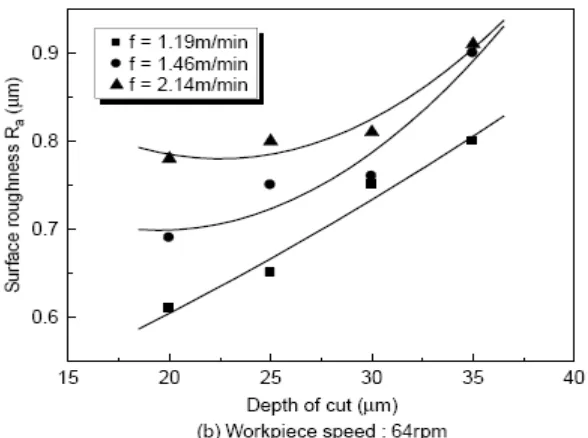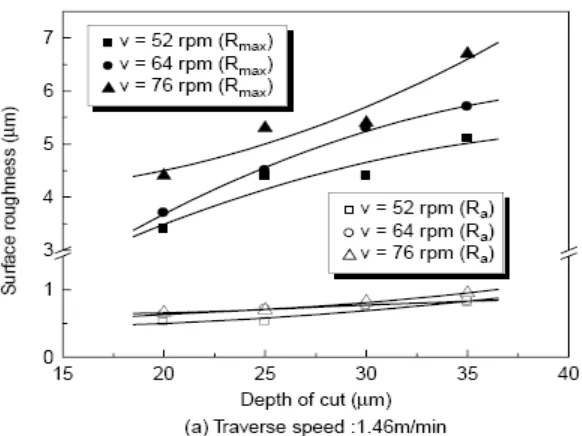AN EXPERIMENTAL STUDY OF THE IMPACT OF
CYLINDRICAL GRINDING PARAMETER ON SURFACE
ROUGHNESS
NURUL HIDAYAH BT ABD RAHIM
ii
DECLARATION
I hereby, declared this report entitled “An Experimental Study of the Impact of
Cylindrical Grinding Parameter on Surface Roughness” is the results of my own
research except as cited in references
Signature :
Author’s Name : Nurul Hidayah Bt Abd Rahim
APPROVAL
This PSM submitted to the senate of UTeM and has been as partial fulfillment of the requirements for the degree of Bachelor of Manufacturing Engineering (Manufacturing
Process). The member of the supervisory committee is as follow:
………
Mr. Mohd Shahir Kasim Project Supervisor
iv
ABSTRACT
v
ABSTRAK
Thesis ini bertujuan untuk menyiasat kesan-kesan parameter ‘cylindrical grinding’ kepada kualiti permukaan bahan ‘stainless steel SUS316’. Proses mengikir atau mengasah permukaan adalah satu proses yang penting bagi menghasilkan produk yang mempunyai ukuran yang tepat dan mempunyai permukaan yang licin dan sempurna.Kaedah yang digunakan untuk menjalankan ekperimen ini adalah
menggunakan kaedah ‘Design of Experiment (DOE) full factorial’ dengan dua level.
vi
DEDICATION
To:
Abd Rahim Bin Ahmad
Esah Bt Mat Nor
Mohd Nor Hakim
Nor Solehah
Mas Izzatul
vii
ACKNOWLEDGEMENTS
I wish to acknowledge and express my gratitude and appreciation to (i) my supervisor, Mr Mohd Shahir Bin Mohd Kasim for his supervision, encouragement, suggestion and assistance through the research; (ii) my parents, Mr. Abd Rahim bin Ahmad and Madam Esah Bt Mat Nor whose constant encouragement, faith and confidence besides continuously moral support
It is a pleasure for me to express huge gratitude to all individuals and colleagues who have contribute so much throughout my study. I could offer here only an inadequate gesture of my appreciation and all of your good deeds will always be in my mind.
Wassalam….
x
4.3 Findings and Data Analysis of Vibration………..66
4.3.1 Pareto Chart of the Effects for Vibration………..67
4.3.2 Main Effects plot for Vibration……….68
4.3.3 Scatterplot of Vibration vs. surface Roughness………69
5. DISCUSSION………...70
5.1 Introduction………70
5.2 Surface Roughness……….71
5.2.1 Depth of Cut………...71
5.2.2 Traverse speed………...72
5.2.3 Work speed………73
5.2.4 Vibration………73
5.2.5 Fault finding chart and correction………..74
6. SUMMARY AND CONCLUSION………76
6.1 Conclusion……….76
6.2 Recommendation………...77
7. REFERENCES ………..78
xi
LIST OF TABLES
Table 2.1 Approximate Specific-Energy Requirements for Surface Grinding 11
Table 2.2 Traverse mode grinding parameter 11
Table 2.3 Ranges of Knoop Hardness for Various Materials and Abrasives 24
Table 2.4 Typical Ranges of Speeds and Feeds for Abrasives Processes 29
Table 2.5 Room temperature mechanical properties and typical application of 316 series steel 33
Table 2.6 A 23 two-level, full factorial design table showing runs in ‘standard Order’ 36
Table 3.1 Factors and levels selected for the experiment 41
Table 3.2 A 23 two-level, full factorial design table showing runs in `Standard Order' 43
Table 3.3 Mechanical Properties of Stainless Steel 316L 44
Table 3.4 Chemical Properties of Stainless Steel 316L 45
Table 3.5 The control panel of cylindrical grinding 46
Table 4.1: Experimental result for surface roughness 61
Table 4.2: Estimated effects and coefficients for surface roughness (coded units) 65
ix
LIST OF FIGURES
Figure 2.1 Effect of depth of cut on surface roughness with constant
workpiece speed 9
Figure 2.2 Effect of depth of cut on surface roughness with constant traverse speed 10
1 technology is highly developed according to particular product and process requirements.
2
In this study, the Design of Experiment (DOE) has been use in order to see the relationship between the variables (feed rate, depth of cut and speed rate) of cylindrical grinding on surface roughness of SUS316L. By doing this project, the surface roughness for different parameter will be determined and will be compared to the various run in surface quality. This research will be focus on understanding the effects of three specific parameters within a small range operating condition.
1.2 Problem Statement
In many industries, one of the final steps is the surface grinding that is use to surface finishing of the product. This process is necessary because forming, shaping and machining process alone do not achieve high enough dimensional accuracy or good quality surface finishes. The important of surface roughness in to the industry is because of a realization of on the important of the manufacturing processes at final step in the design and desired by the industry to reduce cost and to improve the quality of product to compete in an international marketing. The purpose of this research was to find the variable parameter that can produce an optimum effect on the surface roughness of stainless steel 316L. This research has used stainless steel as a material compared to other researchers.
3
The vibration analysis techniques commonly used in industry for machine condition monitoring (S. Ebersbach, Z. Peng, 2008) so as been indicated in this journal a vibration analysis has been considered to be proceeded in this experiment as this data analysis may help practitioner or engineers to improved the noise reduction and signature detection. Through this data, engineers can determine the machine performance and maintain the quality of the products.
To show the relationship between cutting parameter and surface roughness, the experiment has been design by using DOE (Design of Experiment) method. This method is actually appropriate to measure the machine performance and the data has resulted in a short period.
1.3 Objective
There are three main objectives by doing this project:
a) To find the significant and non-significant factors that effect surface roughness on stainless steel 316L.
b) To find the optimum parameter which affect a surface roughness of Stainless Steel 316L.
4
1.4 Scope of project
Several elements were considered in order to achieve the goals of this study successfully:
a) Choose variable parameters.
b) Design of experiment by using DOE method
c) Analyze the surface roughness by using a portable surface roughness measurement.
5
1.5 Project Organization
This project consisted of six chapter including PSM II, and I, which are:
Chapter 1 introduces of grinding process, problem arises in industry, which drive to develop this objectives and scope of this project.
Chapter 2 reviews on the literature from journal, books and internet. The area covered including surface roughness, cutting parameter, vibration etc.
Chapter 3 describes methodology to develop the experiment, the requirement to ensure this experiment completely run.
Chapter 4 containing all the analysis graph about the surface roughness and vibration, interrelation between cutting parameters and surface roughness and relation between vibration and surface roughness.
Chapter 5 discussed the analysis graph and focused on significant effects.
6
CHAPTER 2
LITERATURE REVIEW
2.1 Surface Roughness
In manufacturing industry, surface roughness is an important design consideration. Roughness is defined as closely spaced, irregular deviations on a small scale; it is expressed in terms of height, width and distance along the surface (Kalpakjian, 2006). There are several factors that should to be considering in finishing process to improve surface quality. Surface waviness and surface roughness are the parameters that most commonly in surface metrology. The Roughness produced by grinding was commonly from 0.2 to 0.8 µm (Luca et al., 2004).
After finishing process, it can see the pattern on workpieces which known as surface finish or surface roughness (John, 2004). Surface roughness generally describe by two methods. The arithmetic mean value (Ra) is based on the schematic illustration of a rough surface. Then is the root-mean-square roughness (Rq) formerly identified as RMS.
7
In engineering practice, there is some requirement for manufacturing product for
example Bearing ball is 0.025 μm, Crankshaft bearing is 0.32 μm, Brake drums is 1.6 μm and Clutch-disk faces is 3.2 μm. The result from the experiment can be compared with that value.
2.1.1 Theoretical Model of Surface Roughness
This model is design to understand how cutting parameter affecting a surface roughness. The standard equation is as follow (Vernon, 2003): This equation show that if feed of rate increase then surface roughness increase also. The tool nose radius will decrease surface roughness when the value of re is increase.
2.1.2 Factors Effecting Surface Roughness
8
variable on the workpiece. In order to simplify the problem, one needs to eliminate or select specific variables that correspond to practical application. In this project, the setup variables will be choosing to complete this analysis.
2.1.2.1 Setup Variables
The most commonly variables in cylindrical grinding are the machine setup. Cutting speed, feed rate and depth of cut have a very significant impact on the surface quality. Surface roughness is related to feed rate and work speed (Saglam, 2005). Eduardo et al (2004) noted that roughness increase along with the in feed rates.
Sahin and Motorcu (2005) noted the surface roughness increased with the increase of feed rate but decreased with cutting speed and depth of cut. The feed rate has the most dominant effect on surface roughness value produced by coated carbide tools.
Choi et al. (2007) have developed grinding process models for cylindrical grinding processes based on the systematic analysis and experiment. In the experiment, there are several setup variables including dressing depth of cut (mm), dressing lead (mm/rev), surface speed of the workpiece (mm/s), surface speed of the grinding wheel (m/s) and depth of cut (mm/rev). This experiment was design in three levels and run 18 experiments.
9
Fig 2.2 shows the centerline average height of the surface roughness for different depths of cut and traverse speeds.
Figure 2.1: Effect of depth of cut on surface roughness with constant workpiece
10
Figure 2.2: Effect of depth of cut on surface roughness with constant traverse speed
(Kwak et al., 2005)
Kruszynski (2005) noted that the proper selection process in their analysis is peripheral speed, traverse feed and depth of cut which essential utility of coming up to product quality requirements.
Qian et al. (2000) have use the traverse mode grinding parameter (Table 2.2) in their experiment. This experiment was carry out to investigate a high efficiency precision grinding of bearing steel to evaluate the suitability and feasibility of ELID (Electrolytic in process dressing) grinding as a super finishing technique for bearing components. The samples were evaluated with respect to roughness, waviness roundness and residual stress. The increasing of depth of cut and traverse rate worsens surface finish.


